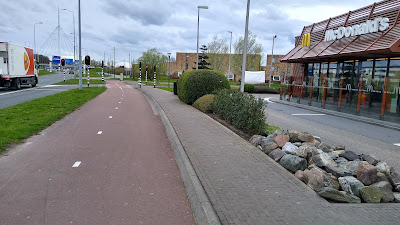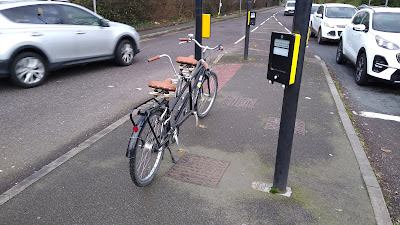My latest trip to the Netherlands took me to Eindhoven and so I simply had to go and have a look at the Hovenring, an often celebrated piece of cycling infrastructure.
The trip to the Hovenring was on the first day of a tour with my son which had started with a ferry landing at Hoek van Holland (the town square shown below), and taking our cycles on the Rotterdam Metro (after 9am on a weekday).
My plan had been to get the metro to Schiedam Centraal, the main station in Schiedam which is still overground before the line dives underground. We would then cycle to Rotterdam Centraal and then pick up the Intercity to Eindhoven. However, I also had an alternative idea to go to 's-Hertogenbosch and then to cycle the 40km south to Eindhoven and that's just what we did as we were able to pick up the Sprinter train from Schiedam Centraal.
I think this was the best option as Sprinter trains have level boarding (above, complete with the extending gap filler to the platform) as opposed to the steps of the Intercity and my perception was that cycle space is tighter in the Intercity.
I think it was the right decision and there was plenty of space for our cycles on the Sprinter (above) and the configuration was such that one could wheel in one door and wheel out of the next to save having to juggle the cycles round (mine is heavy and was loaded up for the trip). I would say that Dutch national railways is similar to the UK in that a cycles are tolerated rather than embraced in numbers and having to pay €7.50 per cycle for a day ticket helps with the discouragement.
Unlike the UK, the Dutch railways make it very easy to cycle from destination stations using their integrated OV-fiets cycles which are usually quite plentifully supplied at stations across the country such as Tilburg (above). Apparently one can get access to these with a UK bank account, but I've not explored the option as it is meant to be awkward, and probably less helpful when carrying two panniers' worth of luggage.
I'll pick up on the cycle from 's-Hertogenbosch to Eindhoven another time, but as we got to the edge of Eindhoven after being battered by a headwind most of the afternoon (the Dutch hill), we thought that we may as well push on to see the Hovenring to leave a bit more time for our next day's adventure.
We picked up the city's oddly named "Slowlane" cycle route which took us past the airport and we followed the "S" centre line markings (above) into the Grasrijk district on the very west of Eindhoven.
The Hovenring eventually swung into view as we crossed Meerhovendreef (above). I had seen plenty of photos, but what was coming up was essentially a circular bridge some 72 metres in diameter and which is suspended over a traffic junction via a single pylon with cables down to the deck and some supports underneath (below).
As we got closer, it became apparent that although not horredously steep, the ramps up to the Hovenring are less favourable than the shallower slope that drivers have to deal with going underneath. I think this really does show that the Hovenring is motoring infrastucture which takes walking, wheeling and cycling out of the picture at (just below original) ground level.
Being up above the large and really busy junction feels much safer than it would be crossing multiple traffic lanes (above), but the project was built to improve the flow of traffic and to accommodate housing development in the area. I think this is slightly glossed over in calling the Hovenring a cycling roundabout, but in the (ahem) round, there is no denying that this is an iconic landmark which does improve safety for people as well as simplifying the junction for drivers.
Up above the traffic, we can see the Hovenring is part of the Slowlane and in common with what we had cycled so far, it was wide enough for two-way cycling and there was the odd person walking over which is perfectly fine.
The Hoventing provides plenty of local connectivity on the edge of Eidhoven such as the new housing (above) and into the adjacent town of Veldhoven.
So there, you have it, an amazing piece of engineering which is now fully part of the local cycling (and walking and wheeling network) in this developing part of Eindhoven.
We used a different ramp to leave - northeast on Noord Brabantlaan because after hours in the saddle and with faces full of headwinds, we spotted something else of interest (above).
Our pre-midday snack in 's-Hertogenbosch had long since evaporated and the call of fast food was irresistable, but it turns out that the restaurant had its very own 60 metre walking, wheeling and cycling spur from the main network, with the latter ending in a dedicated cycle parking area (above).
This spur crossed a left turn slip road from the main road, or to be more accurate, it was the left turn slip that crosses the spur because the traffic signals here are set up to priorise the spur with traffic getting demand-led access. It's always the details in the Netherlands!
I shall leave you with a video of The Hovenring.
































